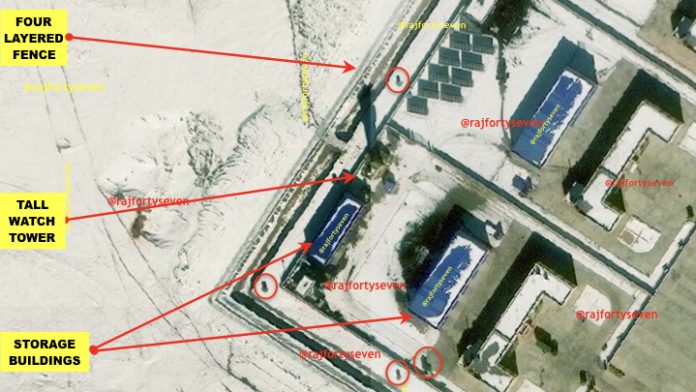 Satellite imagery of PLA's second garrison | Col. Vinayak Bhat (retd.)/ThePrint
Satellite imagery of PLA's second garrison | Col. Vinayak Bhat (retd.)/ThePrint
For nearly two decades, China has been denying rumours that its People’s Liberation Army plans to set up overseas bases, yet over the last few years, the presence of at least one base in the African nation of Djibouti has been confirmed.
And now four days ago, The Washington Post reported that for at least the last three years, Chinese troops have been stationed in the Central Asian country of Tajikistan, a few miles away from its border with China and a proverbial stone’s throw from the strategic Wakhan Corridor in Afghanistan.
ThePrint takes a closer look at this foreign base through open source satellite imagery to understand its significance and its international impact.
Strategic significance
The US Department of Defense and many of the world’s intelligence agencies believed that China would have its second overseas base in Pakistan.
There have also been several rumours on the Chinese internet about some Chinese mechanised vehicles being observed in Afghanistan’s Badakhshan province. Beijing has denied the presence of its troops in Afghanistan, but confirmed that it was carrying out training activities like ‘joint counter-terrorism operations’ with Kabul.
However, the fact that its second base has been spotted near the Wakhan Corridor is of great strategic significance, not just to China but also to South Asian countries.
The Wakhan Corridor is a thin strip of Afghan territory sandwiched between Tajikistan and the northernmost part of the Gilgit-Baltistan region of Pakistan-occupied-Kashmir. It forms a pan-handle for the Badakhshan province, and acts as a buffer between former the Soviet nation and India. It has a 92 km-long border with Tashkurgan county in the Xinjiang Uyghur Autonomous Region of China.
China has a long-unsettled border issue with Tajikistan in this region, and contends that Uyghur Islamic fundamentalism is being propped up through this area.
Although a strategically-important area, the British and later the Chinese have been reluctant to construct roads in this remote location, so it has remained closed to the common public for more than a century now.
The Wakhan Corridor provides China with a passage towards the war-ravaged Afghanistan, as also Pakistan’s Khyber-Pakhtunkhwa province through the Broghil pass.
Thus, it is extremely important for Xi Jinping’s dream Belt and Road Initiative, including the China-Pakistan Economic Corridor.
Location of the base
The Chinese base is located at Kyzylrabot in Tajikistan, approximately 12 km from the Wakhan Corridor and 30 km from the Chinese border.
The base is located very close to an old Tajikistan post, and overlooks the north-eastern prong of the Wakhan Corridor.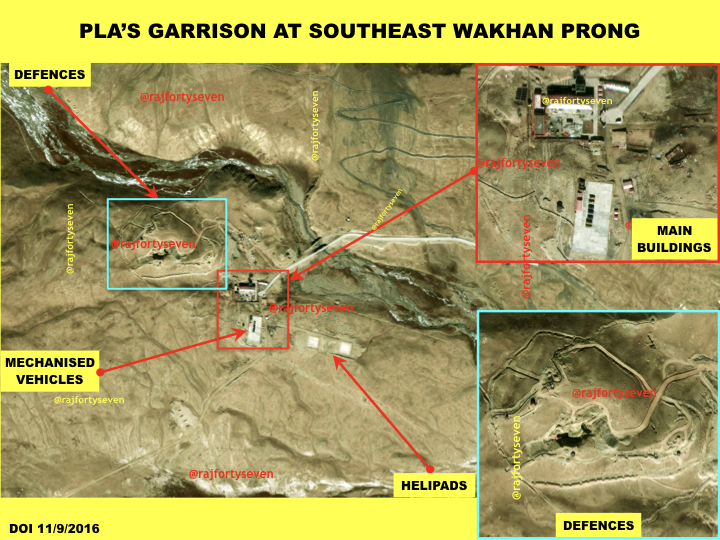 Image credit: Col. Vinayak Bhat (retd.)
Image credit: Col. Vinayak Bhat (retd.)
 Image credit: Col. Vinayak Bhat (retd.)
Image credit: Col. Vinayak Bhat (retd.)
The south-eastern prong faces the Chinese post with a proper road, bridges and other infrastructure in place. It is connected with a 100 km-long black-topped two-lane road up to the Chinese border outpost at Kumla pass.
Main buildings
The base has three main buildings, each of which are two-storeys high, with the ground floor open for parking vehicles.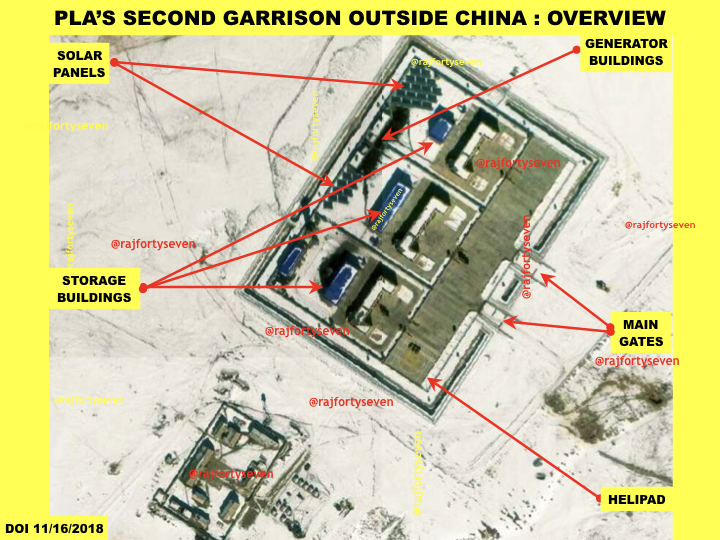 Image credit: Col. Vinayak Bhat (retd.)
Image credit: Col. Vinayak Bhat (retd.)
 Image credit: Col. Vinayak Bhat (retd.)
Image credit: Col. Vinayak Bhat (retd.)
Each of the three buildings is 9m wide and ‘C’-shaped, with two wings each being 20m long and the central section 55m long.
In addition, there are three storage buildings at least two storeys high, two of which are 45m x 16m in size, and third 22m x 16m. There are also two small generator buildings and a solar grid of 8m x 28m panels for electricity.
Tall poles and small dishes are seen on top of the three main buildings, to meet communication requirements.
The complex also has a small helipad in the south-eastern corner, where three-armoured plated vehicles are observed.
Security
The garrison has been provided four-layered security. The main ‘C’-shaped buildings are separated from each other with a solid wall fence with a gate at the western end.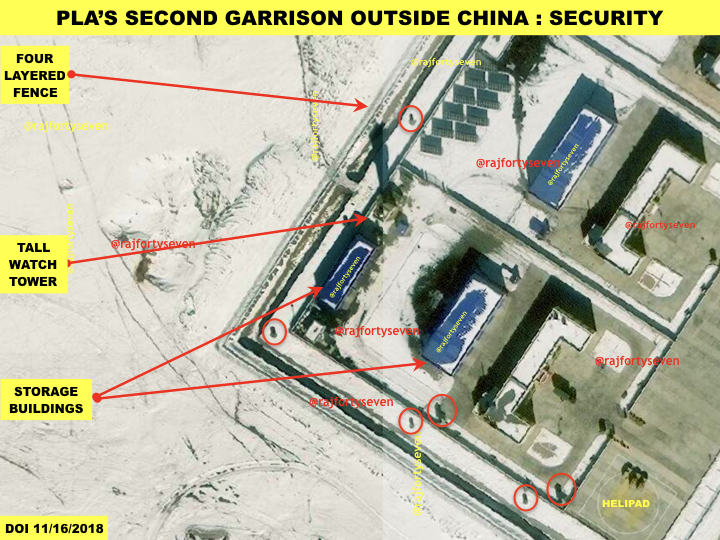 Image credit: Col. Vinayak Bhat (retd.)
Image credit: Col. Vinayak Bhat (retd.)
 Image credit: Col. Vinayak Bhat (retd.)
Image credit: Col. Vinayak Bhat (retd.)
The first and fourth layers are separated from each other by a distance of more than 20m. The first and second layer have 15 raised guard posts with 360° observation.
The garrison has a large, very tall square-shaped observation tower with a 360° view. The tower also has a ground-search radar mounted on top of it.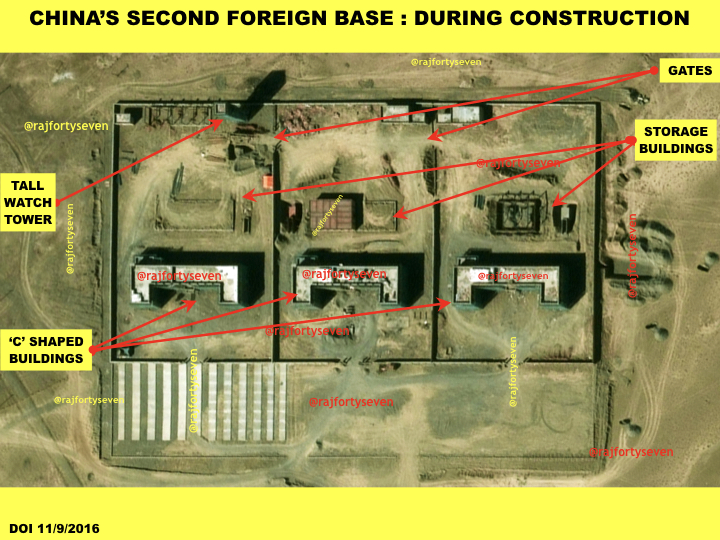 Image credit: Col. Vinayak Bhat (retd.)
Image credit: Col. Vinayak Bhat (retd.)
 Image credit: Col. Vinayak Bhat (retd.)
Image credit: Col. Vinayak Bhat (retd.)
The entire garrison of more than seven hectares can hold anything between a battalion to a brigade worth of troops with support elements.
Future provisions
Although much smaller than the Djibouti base, China’s Tajik base has a larger area outside for future expansion, and for construction of an airport and/or any other support facility.
From the Chinese perspective, the base will allay some fears of the instability in Afghanistan spilling over to Xinjiang.
However, for India and the international community at large, the base is a worrying development, given the ample access it gives the PLA to the all-important Wakhan Corridor.
No comments:
Post a Comment